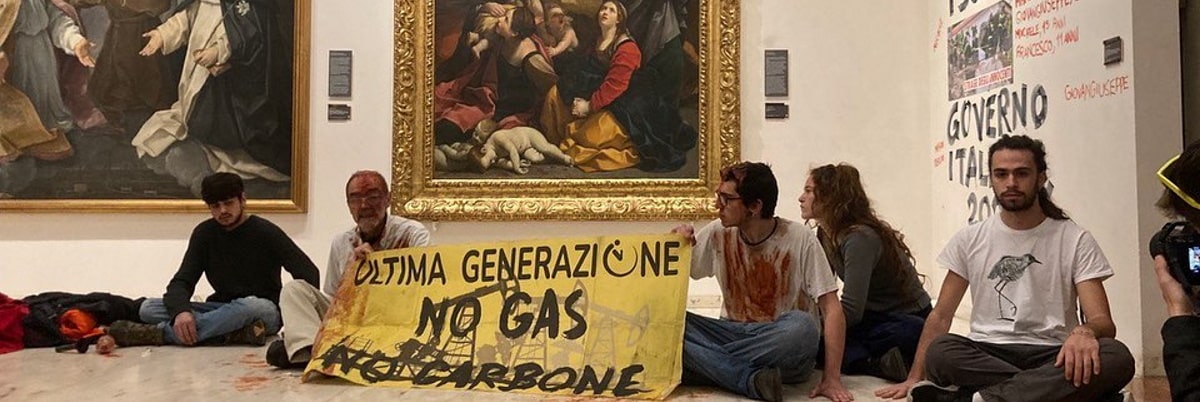by Emanuele Mastrangelo and Enrico Petrucci
There is really nothing to laugh about the action committed by three activists of the fanatical environmentalist group called "Last Generation" by defacing the Palazzo Madama facade last Jan. 2. Nor is it correct to make reductionism. The gesture of the three activists is by no means reducible to just a stupid thing. It is enough to see the more than benevolent reception that the left-wing press - from "Il Fatto Quotidiano" to "Domani" to "L'Espresso," just to name a few - and various political figures and commentators - Orfini, Berizzi, Stefano Feltri - have reserved for the "stupid thing" in question.
The event is serious and complex. The model that best explains it is that of the "Overton Window": it is instrumental in raising the temperature of the debate, bullying the demands of environmental zealots into the agenda setting and slowly shifting the common-sense bar toward their acceptance.
The media and political hype has already begun: the "eco-warriors" (note the coinage on the American "social justice warrior") are "persecuted." Their gesture is "harmless" and they are indicted for a "crime they did not commit." Even those who most democratically "disagree with the methods" however, are ranting to support the cause of the eco-vandals: there is a "catastrophe in the making" and you care about a little washable paint on an old building? The paint is washable, non-toxic, maybe fair trade. It is the same modus operandi of Just Stop Oil activists against artwork. You throw paint or soup towards a painting with bullet-proof glass, vandalize the frame or perhaps the adjoining wall. It is, commentators insist, fake vandalism, an oxymoronic non-vandalism.
That there is widespread tolerance at the political, media and even institutional level for these vandalistic actions is evident. On the other hand, the reaction of the police (all on coffee break during the defacement of Palazzo Madama?) matches the soft line that is applied to other incidents of the same matrix, such as the traffic blockade on beltways and road junctions. The police intervene almost more to stop the exasperation of the motorists and prevent them from doing an hasty justice to the eco-vandals, so as to allow them to do ten minutes of demonstration (which - according to some sources - would normally be preannounced to the concerned police offices so that officers can be conveniently on site and prevent their victims' reactions) in front of the flock of reporters that the environmental organization carries and close it down singing Kumbaya.
The "singing Kumbaya" detail is important: it is true that for decades Italian law enforcement authorities have rightly implemented mostly soft lines of response to public demonstrations with the aim of dampening them without having to resort to force. It is extremely likely that the awareness of having to confront this historic strategy is part of the operational plan of those who maneuver eco-vandal organizations. The risk of getting a few blows is almost zero (indeed, as seen, the police are almost acting as a security force to keep at a distance the ordinary people who are fed up with these fanatics), arrests end with a pat on the cheek, and if they really do trigger a lawsuit there is an army of lawyers paid by the powerful organizations behind them to defend the activists anyway. Not least because activists of this sort have fundraisers that are always active. And, as the case of one of the "activists" who defaced the Senate shows, very good contacts with the media always ready to interview them (one activist was stopped on his way out of a hotel to a TV studio).
The total impunity these individuals enjoy creates in the public opinion the belief that "after all" what they do is not that bad. Not least because is evident the disparity in treatment between the soft lines against, on the one hand, eco-vandals and those who disrupt major roads and the iron fist, on the other hand, toward those categories of protesters who are peaceful but must be perceived as "dangerous" by society as a whole, such as the case of those who opposed the green pass.
But there is more to it. There is not only the Overton Window related to the "environmentalist message" of the Last Generation fanatics, aimed at convincing the people that it will be okay to eat cockroach larvae and give up their cars, freedom to spend and home ownership. As the case of the protests targeting museums and art galleries in recent months demonstrates, there is also the other window thrown wide open on the cancel culture front: attacks on artworks and historic buildings serve to move another bar, that of the public perception of the nation's cultural-historical heritage as a precious treasure to be preserved.
In Italy this belief is very strong and shared by the vast majority of people, even beyond the level of fetishism (think of the typical case of excavations regularly stopped for the discovery of some Roman wall of no value). The cancel culture iconoclasm that has ravaged other countries is hardly coming to us. The infection of this contagious madness finds proud antibodies in the forma mentis of the Italian people.
Well, it is precisely the actions of fanatical eco-vandals that serve to change the perception Italians have of their historical and artistic heritage. Inexorably, the message goes out that a work of art or a historic building is less important than the "message of alarm" delivered by these "stunning and brave" activists (according to the tried-and-true phraseology of American wokeism, which is its first hotbed of infection).
The minds stirring activists do not compartmentalize: the globalist agenda proceeds only seemingly divided but nonetheless strikes united. The imposition of the ultra-environmentalist vision is totally paired with that of the cancel culture that wants the cultural annihilation of peoples and nations through the erasure of their historical heritage. In this sense, the vandal action against a historic and institutional building is perfectly functional to both eco-fanaticism and politically correct wokeism that would like to see all urban landscapes "re-signified" or better yet totally bleached of the traditional values they embody.
So the reaction of the healthy part of politics toward this threat cannot be merely "symptomatic." If wokeism is a social disease - and it is indeed -it is not enough to treat its outward symptoms hoping that the disease will recede on its own. There can be no worse strategy than a political "tachypyrine and watchful waiting" (Minister Speranza's protocol against covid), lowering the "fever" by waiting for the boo-boo to pass spontaneously. Careful counter-strategies must be studied, closely studying what has already happened in so-called "countries more advanced than ours" where the contagious insanity of wokeism has already become unofficial state ideology. Measures aimed at countering Wokeist and environmentalist vandalism should aim not so much at the perpetrators as at overturning the Overton Window that is their real target behind the false flag of defacing a historic building.
Any other initiative would be inexcusable, harmful political amateurism.
Redattore del blog del Centro Studi Machiavelli "Belfablog", Emanuele Mastrangelo è stato redattore capo di "Storia in Rete" dal 2006. Cartografo storico-militare, è autore di vari libri (con Enrico Petrucci, Iconoclastia. La pazzia contagiosa dellacancel cultureche sta distruggendo la nostra storia and Wikipedia. L'enciclopedia libera e l'egemonia dell'informazione).
An essayist and popularizer, his publications include "Alessandro Blasetti. The forgotten father of Italian cinema" (Idrovolante, 2023). And with Emanuele Mastrangelo "Wikipedia. The Free Encyclopedia and the Hegemony of Information" (Bietti, 2013) and "Iconoclasm. The contagious insanity of the cancel culture that is destroying our history" (Eclectica, 2020).












Scrivi un commento